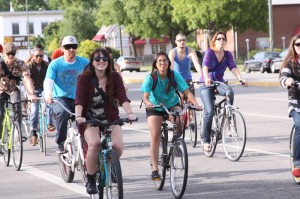
By Michael Wise
As a cycling advocate, I should promote helmet wearing: I’m all about cyclist’s safety, right? If you take one of the League of American Bicyclists courses, you will be required to wear a helmet throughout. It’s a little weird, since the League doesn’t advocate helmets specifically. They’ve latched on to a cultural meme, that only helmeted cyclists are safe cyclists. It’s an interesting meme, but it’s not true: helmeted cyclists are often the least-prepared cyclists. Novice cyclists will wear helmets, and proceed to make dozens of mistakes that could kill them. Not because they were wearing helmets, but because they make bad road choices: riding on sidewalks, riding against traffic, riding at night with no lights.
I don’t believe that you should never wear a helmet. There a plenty of times where helmets are a necessary safety item, such as mountain biking and road racing. But for day-to-day commuting they aren’t that effective. They don’t provide much protection if you are hit by a car. They’re designed for straight-on impacts at less than twenty miles an hour. For most of us urban commuters, that means going over the handlebars, a scary scenario but not a very common one.
Helmets also promote a culture of fear among cyclists. Seeing cyclists wearing helmets gives the impression cycling is unsafe, leading fewer people to choose it as a mode of transportation. Among cyclists, it leads to unsafe behaviors like riding too far to the right out of fear of being hit from behind. This ends up in a vicious cycle, where the cyclist’s impression of acting safely puts them in greater danger. There are more encounters with cars, until the cyclist concludes that cycling isn’t safe, and hangs up the helmet for good.
My most basic premise is the direct correlation between number of cyclists and cyclist’s safety (“safety in numbers”). The more cyclists on the road, the safer they are. The effect is well-documented: cities like Copenhagen have a very low rate of helmet usage, very high numbers of bicycle commuters, and very low numbers of cycling injuries. Some will claim that Copenhagen is a special case, but it’s not: it was a city just like many of ours, heavily dependent on car use, until a concerted political will changed that. We’ve even seen safety in numbers here in Salt Lake City. Growth in cycling happened rapidly, but has not been followed by a rash of cycling-related injuries. Helmet promotion doesn’t promote cycling to non-cyclists in any way: it deters people from cycling. Whatever it may be, that helmets muss the hair, that helmets look funny, that helmets are expensive, that helmets make cycling look dangerous, that helmets interfere with sight or hearing, that cycling requires special kit, these are all things that prevent people from just getting on a bike. So it reduces the number of cyclists, and the danger of cycling goes up.
In Australia, where helmets are mandatory, it is that head injuries went down, but actually the number of cyclists went down so significantly that the head injuries declined as well. Among the remaining cyclists, head injuries increased. Compulsory helmet laws made cycling more dangerous for those who remained.
Wear a helmet if you want. Just don’t think it’s going to help if you’re riding against traffic, at night without lights, on the sidewalk, or running stop signs and red lights. Yes, you’ll reduce your injuries, but why wouldn’t you prefer to prevent them altogether?

